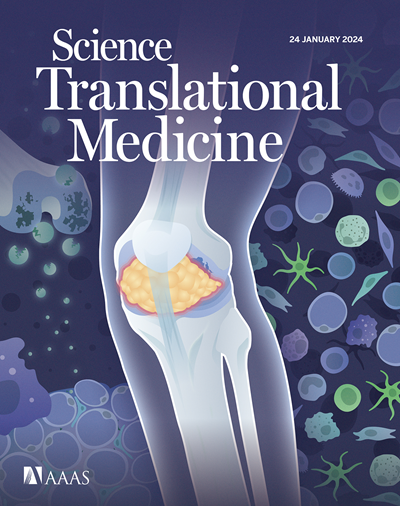A window-of-opportunity trial reveals mechanisms of response and resistance to navtemadlin in patients with recurrent glioblastoma
IF 15.8
1区 医学
Q1 CELL BIOLOGY
Science Translational Medicine
Pub Date : 2025-02-19
引用次数: 0
Abstract
Inhibitors of murine double minute homolog 2 (MDM2) represent a promising therapeutic approach for the treatment of TP53 wild-type glioblastomas (GBMs), reactivating p53 signaling to induce cancer cell death. We conducted a surgical window-of-opportunity trial (NCT03107780) of the MDM2 inhibitor navtemadlin (KRT-232) in 21 patients with TP53 wild-type recurrent GBM to determine achievable drug concentrations within tumor tissues and biological mechanisms of response and resistance. Participants received navtemadlin at 120 mg (n = 10) or 240 mg (n = 11) for 2 days before surgical resection and after surgery until progression or unacceptable toxicity. Both 120 and 240 mg daily dosing achieved a pharmacodynamic impact, but median progression-free survival was 3.1 months. DNA sequencing of three recurrent tumors revealed an absence of TP53-inactivating mutations, indicating alternative mechanisms of resistance. To understand the mechanisms of response and resistance associated with navtemadlin, we conducted functional and spatial analyses of human tissue and patient-derived GBM neurosphere models. Navtemadlin induced partial tumor cell death as monotherapy, and combination with temozolomide enhanced apoptosis in GBM neurospheres while sparing normal bone marrow cells in vitro. We also observed up-regulation of oligodendrocyte differentiation genes with navtemadlin treatment and enrichment of oligodendrocyte transcription factor 2 (OLIG2)–positive cells at relapse, suggesting an unexplored mechanism of navtemadlin tolerance in GBM. Overall, these results indicated that clinically achievable doses of navtemadlin exert pharmacodynamic effects on GBM and suggest that combined treatment with temozolomide may be a route to more durable survival benefits.
求助全文
约1分钟内获得全文
求助全文
来源期刊

Science Translational Medicine
CELL BIOLOGY-MEDICINE, RESEARCH & EXPERIMENTAL
CiteScore
26.70
自引率
1.20%
发文量
309
审稿时长
1.7 months
期刊介绍:
Science Translational Medicine is an online journal that focuses on publishing research at the intersection of science, engineering, and medicine. The goal of the journal is to promote human health by providing a platform for researchers from various disciplines to communicate their latest advancements in biomedical, translational, and clinical research.
The journal aims to address the slow translation of scientific knowledge into effective treatments and health measures. It publishes articles that fill the knowledge gaps between preclinical research and medical applications, with a focus on accelerating the translation of knowledge into new ways of preventing, diagnosing, and treating human diseases.
The scope of Science Translational Medicine includes various areas such as cardiovascular disease, immunology/vaccines, metabolism/diabetes/obesity, neuroscience/neurology/psychiatry, cancer, infectious diseases, policy, behavior, bioengineering, chemical genomics/drug discovery, imaging, applied physical sciences, medical nanotechnology, drug delivery, biomarkers, gene therapy/regenerative medicine, toxicology and pharmacokinetics, data mining, cell culture, animal and human studies, medical informatics, and other interdisciplinary approaches to medicine.
The target audience of the journal includes researchers and management in academia, government, and the biotechnology and pharmaceutical industries. It is also relevant to physician scientists, regulators, policy makers, investors, business developers, and funding agencies.
 求助内容:
求助内容: 应助结果提醒方式:
应助结果提醒方式:


